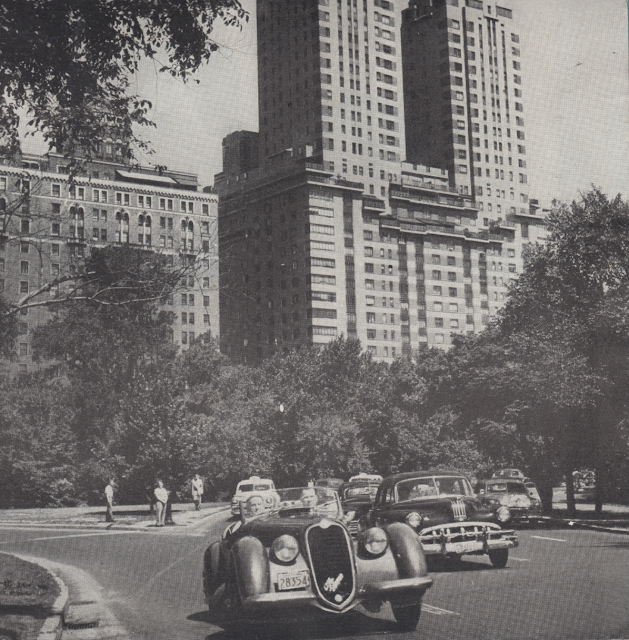It's been a long time since I walked past a showroom window displaying Packards, and I can't remember ever seeing like-new vintage Bugattis, Duesenbergs or Delahayes on display. But you can see these great makes, and others which expired long before today's dreary corporate fad for labeling makes mere "brands", if you visit a former Chrysler dealership now occupied by San Francisco's Academy of Art University Automobile Museum. It's a long moniker, but then again it's a big collection, with around 240 cars in all, of which 52 are on display at their 1849 Washington Street showrooms as part of a rotating display that changes every autumn. Before entering, you catch a glimpse of two cars sharing nothing but an appealing roundness of form: a lightweight Alfa Romeo 2500 road racing coupe built right before World War II, and behind it a lush boulevardier, a Delahaye 175 from the immediate postwar period...
Standing nearby, there's one of the 17 Bugattis bodied in the Atalante style; it's a Type 57 from 1937 and is believed to have been used originally by Jean Bugatti.
This Type 57 features the flat, horseshoe-shaped radiator rather than the vee-shaped prow of the lower-chassis Type 57S and SC. No matter; it has enough presence to distract attention from some imposing land yachts across the showroom floor...
The 1926 Belgian Minerva pictured above featured a sleeve-valve 6.6 liter six cylinder engine built upon Knight patents* and was bodied in aluminum by Le Baron in the United States. It's thought to have been the New York Auto Show car when new.
The very British Daimler Double Six from the same era is even larger, and features sleeve-valves like the Minerva, but here in a V12 engine. The Hooper-bodied car was built for a bus company magnate in Australia. Perhaps it was appropriate that his personal transport was bus-sized, but in the cavernous interior he would have avoided anything like the crowding associated with public transportation.
This Duesenberg Model J is one of around 480 produced by the Auburn Cord Duesenberg combine from 1928 to 1937, with 2 cars completed after the bankruptcy. That figure includes all variants, including the supercharged SJ, the JN and the short chassis, two passenger SSJ. Like many modern cars, the Duesenberg's 265 hp engine features twin overhead cams and four valves per cylinder. Unlike any modern cars, however, the Duesy's engine is an inline eight...
So is this Auburn 851 boat tail Speedster introduced in 1935. The body design, by Gordon Buehrig (who also designed the revolutionary 1936 Cord) was actually a clever restyling of the previous V12 boat tail. The Speedster was built for two years, and with supercharging, the flathead 280 cubic inch engine would propel the car to 100 mph.
*Museum Notes and Thanks:
I want to thank Gogo Heinrich for arranging a special tour of this collection, and Museum Coordinator Paul Borgwardt for spending over two hours with our group, graciously opening up engine compartments and answering questions. Tours are normally available on Tuesdays from 11 AM to 1 PM, and on Thursdays from 2 PM to 4 PM. Museum proceeds go to the Rotary Club, and Boys and GIrls Club. Tours can be scheduled at the web site: academyautomuseum.org.
*Car Notes: The Museum seems to have an interest cars with sleeve valves, and has a rare
Willys Knight roadster. There's more to say about Duesenbergs as well, and we'll get there eventually. And we haven't even started on the Packards, the Stutz Super Bearcat, the Delage and Delahaye, or the Talbot Lagos...
Photo credits: All photos are by the author.
Standing nearby, there's one of the 17 Bugattis bodied in the Atalante style; it's a Type 57 from 1937 and is believed to have been used originally by Jean Bugatti.
This Type 57 features the flat, horseshoe-shaped radiator rather than the vee-shaped prow of the lower-chassis Type 57S and SC. No matter; it has enough presence to distract attention from some imposing land yachts across the showroom floor...
The 1926 Belgian Minerva pictured above featured a sleeve-valve 6.6 liter six cylinder engine built upon Knight patents* and was bodied in aluminum by Le Baron in the United States. It's thought to have been the New York Auto Show car when new.
This Duesenberg Model J is one of around 480 produced by the Auburn Cord Duesenberg combine from 1928 to 1937, with 2 cars completed after the bankruptcy. That figure includes all variants, including the supercharged SJ, the JN and the short chassis, two passenger SSJ. Like many modern cars, the Duesenberg's 265 hp engine features twin overhead cams and four valves per cylinder. Unlike any modern cars, however, the Duesy's engine is an inline eight...
I want to thank Gogo Heinrich for arranging a special tour of this collection, and Museum Coordinator Paul Borgwardt for spending over two hours with our group, graciously opening up engine compartments and answering questions. Tours are normally available on Tuesdays from 11 AM to 1 PM, and on Thursdays from 2 PM to 4 PM. Museum proceeds go to the Rotary Club, and Boys and GIrls Club. Tours can be scheduled at the web site: academyautomuseum.org.
*Car Notes: The Museum seems to have an interest cars with sleeve valves, and has a rare
Willys Knight roadster. There's more to say about Duesenbergs as well, and we'll get there eventually. And we haven't even started on the Packards, the Stutz Super Bearcat, the Delage and Delahaye, or the Talbot Lagos...
Photo credits: All photos are by the author.























